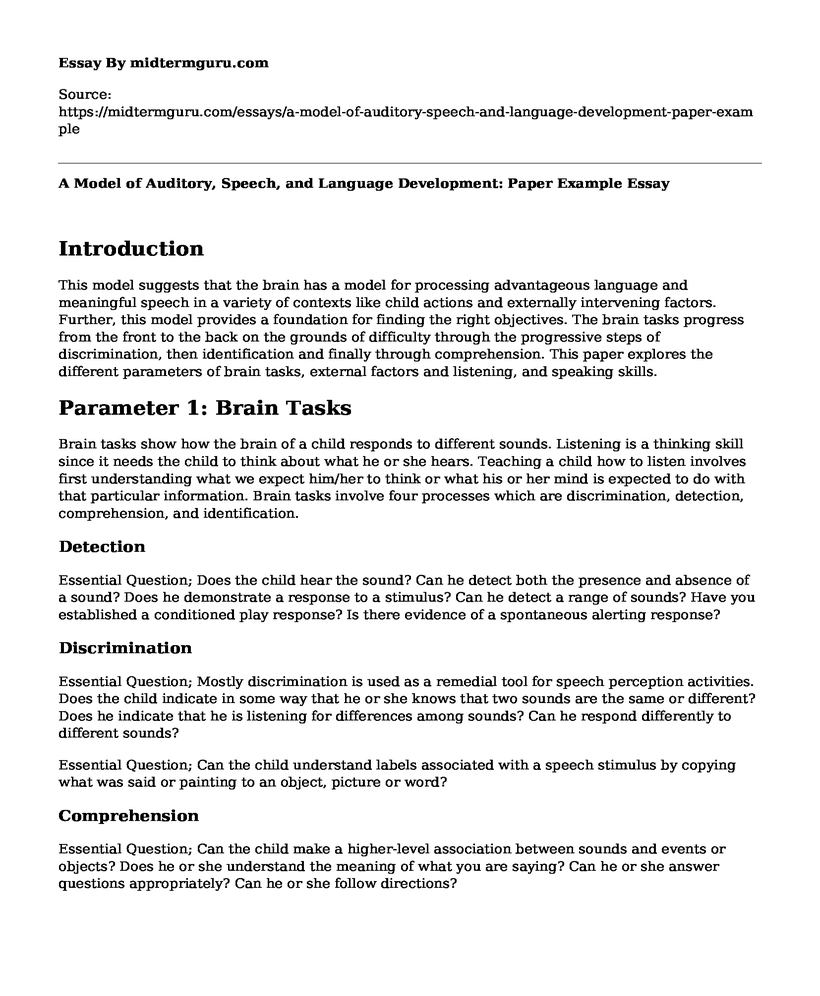Introduction
This model suggests that the brain has a model for processing advantageous language and meaningful speech in a variety of contexts like child actions and externally intervening factors. Further, this model provides a foundation for finding the right objectives. The brain tasks progress from the front to the back on the grounds of difficulty through the progressive steps of discrimination, then identification and finally through comprehension. This paper explores the different parameters of brain tasks, external factors and listening, and speaking skills.
Parameter 1: Brain Tasks
Brain tasks show how the brain of a child responds to different sounds. Listening is a thinking skill since it needs the child to think about what he or she hears. Teaching a child how to listen involves first understanding what we expect him/her to think or what his or her mind is expected to do with that particular information. Brain tasks involve four processes which are discrimination, detection, comprehension, and identification.
Detection
Essential Question; Does the child hear the sound? Can he detect both the presence and absence of a sound? Does he demonstrate a response to a stimulus? Can he detect a range of sounds? Have you established a conditioned play response? Is there evidence of a spontaneous alerting response?
Discrimination
Essential Question; Mostly discrimination is used as a remedial tool for speech perception activities. Does the child indicate in some way that he or she knows that two sounds are the same or different? Does he indicate that he is listening for differences among sounds? Can he respond differently to different sounds?
Essential Question; Can the child understand labels associated with a speech stimulus by copying what was said or painting to an object, picture or word?
Comprehension
Essential Question; Can the child make a higher-level association between sounds and events or objects? Does he or she understand the meaning of what you are saying? Can he or she answer questions appropriately? Can he or she follow directions?
Parameter 2: Listening and Speaking Skills
Listening to the spoken language's foundation. Listening and speaking skills have various components which include diphthongs and vowels, suprasegmentals, phrases, words, and connected speech. These are the main blocks of the spoken language.
Essential Question; Does the child demonstrate that he or she hears the differences among patterns of sound that are composed of different durations, stress, intonations or elements of phrasing?
Vowels and Consonants
Essential Question; When helping a child listen to the differences between vowels and consonants, do you provide a sufficiently noticeable difference by working between vowel or consonant categories before working within vowel or consonant categories?
Connected Speech
Essential Question; Can the child identify critical elements in connected discourse? Can she identify elements in practiced sentences, in conversation, and in connected discourse tracking?
Parameter 3: External Factors
All four external factors are present during any classroom related listening task. There are four categories of external factors.
Stimulus Array
Essential Question; is the child able to respond to an open-set stimulus array, or does he need a closed or a limited set? Does the child need to have materials modified?
Linguistic Complexity
Essential Question; At what linguistic level is this child? What are the key traits of that linguistic level? In what basic level of complexity must I place stimuli: single words or phrases? Can my child respond to stimuli in carrier phrases, and where within the phrase should the stimulus reside? How many elements can the child retain?
Contextual Cues
Essential Question; Does the child need a lot of verbal, visual, pictorial or situational cues, or does she understand auditory tasks within minimal context?
Background Noise
Essential Question; is the child able to listen in all levels of noise from quiet to competing for messages?
Parameter 4: Child Actions
Essential Question; are the activities you are asking the child to do age and interest appropriate?
Cite this page
A Model of Auditory, Speech, and Language Development: Paper Example. (2022, Sep 15). Retrieved from https://midtermguru.com/essays/a-model-of-auditory-speech-and-language-development-paper-example
If you are the original author of this essay and no longer wish to have it published on the midtermguru.com website, please click below to request its removal:
- Statement of Interest for Business MBA Program Master of Accounting
- Paper Example on NAEYC Standard 7 and 8 Teaching Practices
- Why College Tuition Should Not Be Free - Argumentative Essay
- Business English - Essay Sample
- Board Games: A Tool for Cognitive & Behavioral Development - Essay Sample
- Integrating Language Arts & Social Studies: 5-Day Lesson Plan - Essay Sample
- Government Intervenes to Support Healthy, Safe Community for Kids - Essay Sample







